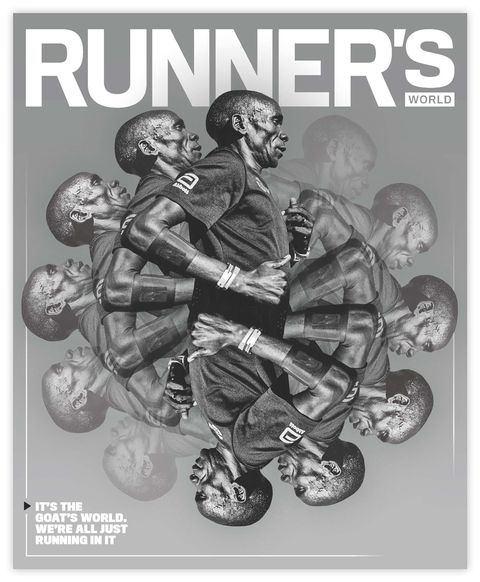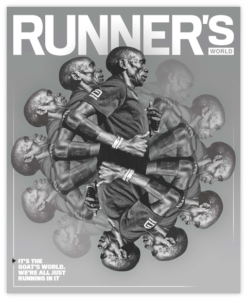
by Coach Adolfo Salgueiro | May 30, 2023 | Article, Coaching, List, Reflection
By Coach Adolfo Salgueiro
The most recent print edition of Runner’s World Magazine (2023/3) was Eliud Kipchoge centered. It had 8 stories that told us from his humble origins to his monastic lifestyle to a dissection of every detail of his record-setting running shoes to Evans Chebet as his most likely successor. It is the most detailed account I’ve seen of Kipchoge related info in one place.

Runner’s World magazine cover for the issue with the 8 Eliud Kipchoge related stories
The story that caught my attention is titled “Train Like Kipchoge (Sorta)”, by Sarah Gearhart, in which she shares five key aspects of Eliud’s training. My first thought was: how can we transfer them to us, simple mortals, to improve our running results. The article talks about how the greatest of all time (GOAT) does it, which doesn’t mean we must apply it in the exact same way. The key is to harness the key lesson of each one and make it part of our current circumstances.
These are the five principles, as per Runner’s World, with a personal commentary on how to apply it to our recreational runner training repertoire:
1 – Sleep like your run depends on it: Kipchoge sleeps 9 hours a night and takes naps. Most of us don’t have the time for that, but neither we are professionals, nor do we run 120 miles per week. The point is to be purposeful about your sleeping habits. Sleep as much as your body needs and don’t brag about your lack of sleep as a badge of honor. Our body recovers and rebuilds while we sleep, which is more valuable than all other recovery tools in your arsenal put together.
2 – Revive Sore Muscles with an Ice Bath: He takes 10-minute ice baths twice a week “to aid his post run recovery.” As recreational runners we may not have the facilities, the time or will tolerate this uncomfortable activity. But the point is that it works for him and despite the pain and inconvenience, he does it anyway because he works diligently on his recovery. Remember that you don’t become a better runner just as you finish your hard workout. You become a better runner once your body has recovered and adapted to the stress it just went through. So, be as diligent as Kipchoge in your recovery.
3 – Upgrade Your Diet with Protein: Kipchoge’s high-carb diet is essential for his training and performance, yet in 2017 he upgraded his protein intake “to aid his recovery as well as help to build and maintain his lean muscle.” The point here is that diet is key to training, performance and recovery. It is not a matter of how many calories we take in but the quality of those calories. If we fuel with a dozen donuts and a pint of ice cream, our weekly milage or our daily nap won’t really provide the benefit they should.

Stationary biking is one of the multiple options to enhance your aerobic capacity without overtaxing your system (Photo: William Adams, Pexels)
4 – Meditate to Build Mental Strength: Kipchoge is a “mindful runner” says his coach Patrick Sang. “While training and racing, he focuses on his breath and his movements, and aims to minimize outside distractions.” While not all of us can or want to live Kipchoge’s spartan life nor we have the will to perfecting the art of mindfulness, we can separate 10 minutes for daily meditation, we can read a book on mental toughness or practice the visualization of our goals without becoming Zen masters.
5 – Build Bonus Endurance on a Bike: Interesting to note that to add to his training volume “without increasing his risk of a running injury, Kipchoge rides a stationary bike for an hour twice a week after his runs.” For mere running aficionados like us, this is what we call cross training. Participating in a non-running activity once or twice a week to enhance our strength or aerobic training while resting our muscles and soft tissues from the pounding of running. Biking, rowing, weight training, yoga, elliptical, etc. Make sure you do something other than running to complement your training.
If these techniques work for the GOAT, scaling them down to our level would be beneficial. Don’t just think about it, do something about it and don’t take too much time getting started. Marathon season is around the corner.
To read the full Runner’s World article, you may click here.

by Coach Adolfo Salgueiro | Sep 27, 2022 | Article, Coaching, List, Science
As the fall and winter marathon season starts heating up, and as the preparation for the spring marathons approaches, I feel appropriate to repost an article I wrote last year, that it is still relevant at this time of the running season. Enjoy!
By Coach Adolfo Salgueiro
Tapering time approaches for those about to run the Abbott World Marathon Majors this year. Training time approaches for those eyeing their marathon towards the end of 2021 or start of 2022. So, seems like a good time to review some basic mistakes that runners, from beginners to experts, should avoid. This way they can reap the most benefits out of their efforts.
Training for a marathon is a process that involves multiple moving parts that need to work in sync. It needs to reach a point where the body can be stressed enough to compensate its deficiencies and adjust to the workload-thus improving- but not to a point where it becomes too much, and it can’t recover to do it again. This means overtraining and, most likely, an injury if intend to tough it out and train through it.

No need to overstress yourself if you avoid these basic mistakes in your training (Photo by Pexels.com)
The following are nine of the most common mistakes runners incur into during a marathon training cycle:
1 Running the long runs too fast: There is a time to go fast and there is a time to go slow. The long run has that name because it is designed for you to go long. It is not called the “fast run” for a reason. They are intended to build up your aerobic system, which, for a marathon, it is used 99% of the time, even if you are the world-record holder.
2 Focusing too much on the long run: The long run is an important part of your training, sure, but it is just one element, not the bulk of it. The success in your race will depend on the accumulated effect of all the elements in your training, not just one.
3 Doing the same workouts all the time: Because about 80% of the training needs to be done at a slower speed, there is a small number of hard sessions available, usually no more than two per week, so distance, speed, intensity, and other parameters, need to be worked so the body can benefit and adapt.
4 Poor fueling and hydration plans: if you don’t test strategies during training, you won’t know what works for you. The time to find that out is during training, long runs, especially. The time to realize a certain gel upsets your stomach, is not during the race. Same applies to hydration. What to drink and when needs to be part of race plan, shouldn’t be improvised on race day.
5 Skipping rest days: Not running on a specific day is part of your training. These days should be written into your schedule and followed to the tee. No amount of ice baths, compression socks or protein shakes will do you any good if you don’t give your body a break to recover so it can run again.

Rest is as part of your training as your work. Don’t skip it!
6 Not scheduling cutback weeks: During training you build up endurance, aerobic capacity, Vo2Max, and multiple additional parameters. But you can’t build up forever. Your body has a limit and needs time to actively rest so it can adapt to the benefits provided by your workouts. Programming a week to cut back on your training provides your body with time to adjust and recover, is key.
7 Cutting sleep: Remember you don’t improve when you work out, you improve while you sleep. The long run the tempo, the weightlifting, or the speed session damage your body. It is when you sleep that your body gets repaired. If you skip on sleep, you won’t realize all the benefits of the training, but you will keep the muscle damage.
8 Screwing up the tapering: Physiological adaptations after exercise, take between two and three weeks to adapt. So, there is no benefit on one last long run in the last couple of weeks. You need to actively rest and recover your body so it will be in its best shape for race day. During tapering there is nothing to gain, yet a lot to lose.
9 Following someone else’s training plan: There is nothing wrong with talking to your buddies about what they are doing, but they may not have the same goals as you and you do not have the same physiology as them. Set up YOUR PLAN, adjust as needed, and stick to it. Trust your coach. Trust your plan. Trust yourself.
Of course, there are more than nine mistakes you can incur during a marathon training cycle. These are just some of the most common and they mostly apply to any distance. As you finish your training for your Abbott Marathon Major or get ready for your upcoming goal race, make sure you are on the lookout for the aforementioned mistakes, so you won’t screw up your hard work.

by Coach Adolfo Salgueiro | Aug 16, 2022 | Article, Coaching, Reflection
By Coach Adolfo Salgueiro
It is human nature to doubt when your running is not going your way. You doubt your training, or your training plan, or your gear, or your health, or your coach. Especially as racing season or your goal race approach and you may not be hitting all your workouts or paces on the dot. I am not saying it can’t be one or more of those topics, maybe a combination of all of them, sure. Yet, if you’re able to identify the culprits and tweak your training, you fall in the category of the perfectly normal runner. These things come with the territory.

Doubting during a difficult time is human nature, but it doesn’t necessarily mean defeat (Photo by Andrea Piacquadio, Pexels)
It is imperative differentiate if what’s happening is an isolated incident or a chronic issue sabotaging your entire training cycle. I recently had a trainee questioning his training because he couldn’t hold marathon pace on a 3rd 2-mile rep within a 14-mile long run. It was later determined that he started way too late, so it was too hot; a rest day was skipped, and not enough water was consumed during the training session.
An athlete must understand that all workouts have a specific purpose, and workouts are interwoven with each other. A long run alone means nothing without the speed workouts, cross trainings and rest days that compliment it. Understanding the objective of each workout is a shared responsibility between runner and coach.
These are some factors to consider when doubt starts creeping into your training, so you can return to the path of success and be in a position to conquer your running goals:
Training vs. Racing: In 40 years of running, I’m yet to see the first medal or podium for winning a training run. Too many runners train at 100% effort on a regular basis, not understanding they are undermining their performance by basically racing once, twice or even three times a week. Training is training and you shouldn’t be racing through it. It is that simple. If you train at 80% effort, you should be able to race at 100% effort. It is basic physiology. If you run faster, you will run shorter.
Long run: Sure, it is one of the staples of training and one of the most important drills in our entire plan. But on its own, it does nothing for you. If you don’t run throughout the week, if the long run occupies too large a percentage of your mileage or if you are running faster than prescribed, you won’t be reaping the benefit you are supposed to obtain. Even worse, you could end up injured.

If your training runs end up with this feeling, you are in for a rude awakening (Photo Pexels)
Peaking: Most have questioned at one time, how am I supposed to run 26 miles in October if we can barely make it through 16 in July. And the answer is quite simple: follow your training plan. It is designed to help you run a certain distance, at a certain pace, on a certain period. It is not good to be ready to run goal distance at goal pace, 6-8 weeks before the race. It is physiologically impossible to keep yourself at top performance condition beyond 3-4 weeks, so the time to peak must be managed.
Accumulated Fatigue: As training evolves, the athlete accrues fatigue. This results in heavy legs or not hitting the mark on certain training sessions. When you need to run 20 miles, or 10×800 with four weeks to go on a marathon training cycle, you should be very tired. It is normal. But remember a tapering period is on its way so you’ll be to get the starting line with fresh legs and a strong mind.
Recovery: Runs together with fatigue. Recovery is as important of an element in a training plan as the work itself. Now, as you train hard, the time will come when a recovery run or one off-day is not enough. Be smart and take an additional off-day or a recovery week if needed. Be wise and don’t overtax yourself by completing a specific workout when your body just doesn’t have it on any given day. You are better off cutting a few miles or a couple of reps than spending additional days recovering from an excessive effort.
Adrenaline: Be mindful that race conditions are way different than training conditions. Starting a pre-dawn run around your block is not as appealing as the starting line of the Berlin Marathon or arriving to First Avenue at the NYC Marathon. The spectators, the surroundings and your excitement will give you an adrenaline boost to carry you through. So, don’t overthink it if you lack enthusiasm for a few days. It is covered during race day.
While many of these parameters seem to be common sense, it comes the time when the obvious must be stated so a struggling athlete can be guided to that eureka moment that will allow him/her to regain the trust in the process.

by Coach Adolfo Salgueiro | Apr 12, 2022 | Coaching, List, Reflection
By Coach Adolfo Salgueiro
As runners, we would all like to improve on a weekly or monthly basis. If we could set up PRs in all our trainings, races and in all our distances, why wouldn’t we? It must be a lot of fun. But the human body is not set up for an indefinite, upward linear progress. There comes a time when such progress wanes down. And there are also times when you get in a running rut.

Keeping the motivation alive is the key to the success of your running journey (Photo: run-ffwpu, Pexels)
It is easy to lace up and hit the asphalt or the trail when things are going well. When you are running in-the-zone, effortlessly, when the miles pile up without feeling them. But the key to becoming a successful and life-long runner is to be able to keep your motivation up when things are not going well. When you are injured, when you can’t figure out why your body doesn’t give you more than 4 miles, when it hurts just to think on putting on your running shoes, when everything just sucks.
Fortunately, there are plenty of strategies to apply to keep that running journey alive. To get back to where you want to be. Here are eight of them:
1 – Create feasible, short-term goals to keep you focused: Regardless of where you are on your journey, having an achievable goal in front of you is crucial to keep moving forward. The operating adjective here is “achievable”. Even amid a long-term goal, such as a BQ in 3 years or running 2000 miles this year, you must structure a plan that will allow you small triumphs to keep your dream and your motivation alive.
2 – Register to a race, now: I am convinced there is no bigger motivation out there than being registered to a race. This way, you know you need to be ready to run X distance by X Day. This will allow you to set up a plan, set expectations and motivate you to keep moving forward during the inevitable challenging times. Even more, let everyone know you have registered, so it is even tougher to back out.
3 – Find a running partner/group: While running could be the perfect time for introspection and solitude, having a running partner with similar goals to be accountable to, is always a good strategy. You can also join a running group or team where you can find yourself welcomed and become part of your local running community. This will change your running life. Guaranteed.

Diet doesn’t have to be fancy. Just eat more of the the good stuff, cut the junk, and you will see immediate improvements. (Foto: Polina Tankilevitch, Pexels)
4 – Dial in your nutrition: If you eat junk all day, there is no training plan able to help you become the best runner you can be. Nobody expects you to never again eat a donut, but you can’t eat six them and flushing them down with Coke, every single day. A solid and balanced diet will take you a long way. It doesn’t need to be a fancy nutrition plan. Eat your veggies, consume good carbs and fats, take it easy with the alcohol and don’t overindulge. That alone, will take you a long way.
5 – Make rest part of your program: You can work as hard as you want, but if you don’t allow your body to heal and repair, you will become overtrained and injured. Not a matter of if but when. Cross training days, when your body works out but doesn’t receive the pounding, or a weekly day with nothing in your schedule, should be an integral part of your plan, so you can keep healthy and so you won’t burn out.
6 – Do not sacrifice sleep: Remember you don’t improve when you work out, you improve while you sleep. The long run, the tempo, the weightlifting, or the speed session damage your body. It is when you sleep that your body gets repaired. If you skip on sleep, you won’t realize all the benefits of the training, but you will keep the muscle damage. It is that simple.
7 – Work with a coach: This is not a self-serving tip. There are reasons why even multi-billion dollar companies hire consultants. Someone who can see things from the outside and assist in maximizing their resources to improve results. Same applies to your running journey. The knowledge and experience of a specialist at your service, can only enhance your experience and thus, your performance.
8 – Just have fun: If you don’t have fun, you won’t last as a runner. It is that simple.
Any other tips you may want to contribute?

by Coach Adolfo Salgueiro | Apr 5, 2022 | Article, Reflection
By Coach Adolfo Salgueiro
As adults with a full life, alcohol is a ubiquitous part of most of our lives. Some of us enjoy the occasional drink in a social setting, some have one every day, some can’t stop consuming it, and some finally overcame alcoholism.
As far as I have read, there’s no proof that the occasional post-run beer will wreck your recovery, nor that it will help it either. Yet, alcohol has undeniable social benefits associated with consuming responsibly it with your buddies, like after a run. I am not a scientist or a wine drinker, but I’ve read about the benefits of a glass of wine when it comes to HDL cholesterol and antioxidants. I’ve also read how more is not necessarily better. You should not be having 3 or 4 glasses because it the positive effects don’t necessarily compound.

A post-run beer has many social benefits and won’t ruin your recovery. The operating word here is “A”, meaning “one”.
I am not here to proselytize on alcohol consumption, which is a personal choice. But as athletes wanting to improve on our fitness and/or racing times, we need to be aware what are the negative effects that too much alcohol can have on our recovery, which is half of our training (Work + Recovery = Training).
For starters, alcohol is a diuretic. A diuretic is a substance that promotes the increased production of urine. This means that it produces dehydration, a big problem for runners. The consequences of moderate dehydration are, among others, cramps and fatigue. Severe dehydration, which can occur after combining drinking and running, include urinary and kidney complications, low blood volume, heat-related injuries and even seizures. As if that weren’t enough, I am sure that running with a hungover must suck all the joy we could get of the sport.
As I was researching this topic, I googled “alcohol and running” and, among the 812 million results I got, the very first one was this paragraph, which resumes most of what I wanted to say: Alcohol is a powerful diuretic, and dehydration is never a runner\’s friend. The risk for muscle cramps, muscle pulls, muscle strains and general fatigue increases when dehydrated, so drinking extra water after a night of hitting the bars is more than necessary to regulate your body for your next run.”
As we have mentioned in this blog, many times before, the number one recovery tool in your arsenal is sleep, which is the time your body uses to repair itself from the pounding of your training and the stress of your day. Alcohol consumption affects and impairs your sleep. Don’t let anyone fool you by telling you that drinking makes them sleepy like a baby, so it doesn’t affect them. Even if you are asleep, drinking in excess will affect your REM sleep, which restores your brain and is good for your memory and learning. Sounds kind of important to me.

Wine has plenty of documented benefits, but they do not compound the more your drink.
Consuming alcohol in excess, also affects your fitness, which is the capacity of your body to recover so you can do it again. If your liver is too busy processing the excess alcohol you consumed, it would not be able to assist repairing of your body, which is needed after every training session, regardless of how easy it was.
The definition of “excess” is personal and individual. What is suitable for a fit, 200-pound male, may not be suitable for a 115-pound female recovering from Covid. Each runner must understand what is good for their lifestyle and make sure they can live with their decisions.
In a podcast I recently listened, Coach Jonathan Marcus made a comparison between two separate issues. One of those fits perfectly in what the last paragraph was explaining: “You can down a whole bottle of wine in 45 minutes. You can do it. You can, physically, get the liquid into your stomach. But what is going to happen afterwards is not going to be pretty. Or, you can have half a glass of wine in an-hour period, sipping on it though dinner, multiple nights in a row and enjoy it as part of a meal. Your body can extract the nutrients, flavors, etc. from that, versus being overly consumed by the poison of the alcohol that then forces a harsh and severe, nasty metabolic response”.
This post is not for pointing fingers, preaching on lifestyle or proselytizing on the virtuosity of abstention. Just make sure you understand what the consequences of mixing running with alcohol are for both your body and your training, so you can make the right choices when the time comes.















